(This article was written as an exclusive for Counterpunch magazine, where the full story can be read, along with photos of the crime scene). It is the first of a three-part series.
Ibragim Todashev, 27, a Russian immigrant friend of suspected Boston Marathon bomber Tamerlan Tsarnaev, was shot and killed last May 22 in the middle of the night by the FBI at the violent end of a five-hour interrogation in his home in Orlando. Now the FBI, ten months later, is claiming that its agent was attacked by Todashev, and was justified in killing him. But a Counterpunch investigation raises grave questions about what really happened in that apartment.
While it’s of course conceivable that this was just a hugely botched investigation by two inept and bungling FBI agents, our investigation suggests that Todashev may have been killed trying to flee a brutal interrogation, and that he may have even been deliberately executed by the FBI.
Questions raised in this case range from why FBI agents failed to follow Bureau’s long-established interrogation protocol, leaving just one agent to question the witness, to why a suspect known to be a competitive mixed martial arts expert was left unrestrained during a hostile and high-pressure interrogation, how Todashev was shot, including a bullet to the top of the head, and finally to how he could have been shot seven times, clearly with intent to kill given where he was hit, if he was considered by the Bureau to be a key witness in the Boston Marathon case.
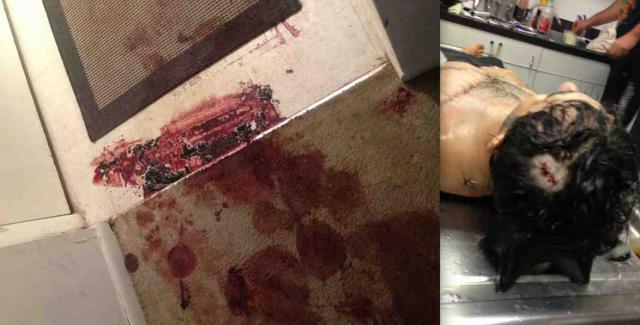 The exit from the room of the interrogation into the foyer to the front door, showing where Todashev was shot and died, and a photo of his body, as it appeared when provided by the coronor to his widow, showing the FBI shot to the head
The exit from the room of the interrogation into the foyer to the front door, showing where Todashev was shot and died, and a photo of his body, as it appeared when provided by the coronor to his widow, showing the FBI shot to the head
The FBI and other law enforcement sources, as I reported earlier in the online publication WhoWhatWhy.com, have leaked a series of widely at odds explanations to selected mainstream news media organizations as to how and why Todashev was shot and killed. Initially Bureau sources leaked to reporters that he had variously grabbed a sword off the wall, or left the room and returned from the kitchen with a pipe or a broomstick, or alternatively with a knife.
All of those leaked stories foundered on common sense. The “sword” in question turns out to have been a decorative scmitar with no sharp edge, hung on the wall and with a broken handle. There was no explanation for how the agent, who may have been accompanied in the room by a Massachusetts State Trooper, could have allowed Todashev to leave his seat and go to that sword, or alternatively to the kitchen area of the room to pick up any of the other alleged implements of destruction. Ultimately, the Bureau conceded that Todashev had actually been unarmed the whole time.
But the FBI has later claimed, in leaks to selected reporters, that Todashev, left unrestrained that night (in marked contrast to other occasions when he had been cuffed) had lunged across the interview table at the interrogating agent, causing the agent to fear for his life and to shoot him in self defense, by one leaked account firing first four times, dropping his alleged assailant, and than three more times when, surprisingly, he attempted to stand again.
A 10-month “investigation”
For ten months, the FBI, claiming it was “investigating” this shooting by its agent, took the unusual step of blocking a Florida coroner’s report on the shooting death — one that was completed within days last May by the Orange County/Orlando Medical Examiner’s Office. The FBI also sought, unsuccessfully, to prevent Todashev’s family from recovering and burying the body, insisting there would have to be permission obtained from his parents in Dagestan, as well a presentation of hard-to-obtain documents like his Soviet-era birth certificate. The Bureau in that instance was overruled by the Medical Examiner who, on humanitarian grounds, handed over Todashev’s bullet-riddled body to his widow and mother-in-law, which is why we have photos of his injuries available, which were taken by a family friend.
But an exclusive interview last week by this journalist of Deputy Chief Medical Examiner Gary Utz, who personally conducted the Todashev autopsy, confirms that Todashev was shot seven times by FBI bullets, four times in the torso, two times in the left arm (he was right-handed), and once in the top of the head, slightly towards the back of the head. A significant bruise and contusion over the cheekbone showed he also had been “forcefully struck” on the left side of the head, in Utz’s words — a point that had never been mentioned by the FBI.
Bruising does not occur to a significant extent once a person is dead — especially if the heart has been destroyed by bullets and there has been significant loss of blood — since there is no blood pressure to push blood out of damaged blood vessels into surrounding tissue. This means it is likely the blow suffered by Todashev came before he was shot.
An Open Homicide Case
Coroner Utz, who has classified Todashev’s death as a homicide, while not determining whether it was justified or not, says he “cannot understand” why the FBI has blocked the Medical Examiner’s Office from releasing his report. He called the Bureau’s hold order “somewhat unusual.”
He added, “It just makes everyone suspicious.” It’s apparently a sentiment he shares, as he also said, “If the FBI didn’t have a problem with our report, it would already be released.”
Cyril Wecht is a renowned forensic pathologist, former Allegheny County Coroner and also head of the advisory board of the Wecht Institute of Forensic Science and Law at Duquesne University. In an interview with this reporter last week, he said he agrees with Utz, saying, “The FBI’s investigation of the shooting should have been released long ago, and the coroner’s report, too.”
Meanwhile, photos of the room taken on the day that the FBI unsealed the apartment as a crime scene, and provided by Todashev’s mother-in-law, Elena Teyer, appear to show that the only significant bloodstains in the room are at the point where a foyer leads out of the room to the front door of the ground-floor apartment. There is no blood visible in the photos in other parts of the room, including across the floor from the rear of the room where Todashev was reportedly being questioned as he sat on the end of a bed, separated from his FBI interrogator by a low coffee table. Significantly, there is no sign of blood in the photos, either on the carpets covering the floor or on the room’s white-painted walls. Where there is blood, there is a copious amount of it, making it clear that one spot just before the foyer is where Todashev was shot and where he died, moving no further.
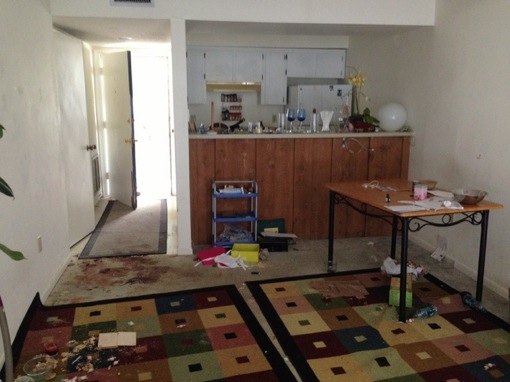 full view of Todashev livingroom and foyer, showining the location of the blood where he died (and the lack of blood elsewhere on the floor.
full view of Todashev livingroom and foyer, showining the location of the blood where he died (and the lack of blood elsewhere on the floor.
Teyer says the photos were taken exactly as they found the roughly 10-foot-by 24-foot room. There was evidence that the FBI had tampered with the crime scene before unsealing it and allowing the family’s investigator in. The agency also had a list of 61 items it had removed from the room.
Follow the Blood
Teyer, a six-and-a-half-year active-duty member of the US Army, where she holds the rank of Specialist, working as a pharmicist’s assistant at the Ft. Stewart Army Air Base in Savannah, GA, is a 2006 Russian immigrant and a naturalized US citizen. In an exclusive interview, she says that the first thing the licensed private investigator hired by Todashev’s Russian family said when she and Todashev’s widow Reni Manukyan came to the apartment with a key and let him in was, “Look at this – no blood spattered on the walls. He was shot while down on the floor.”
That investigator, Ed Busquet, a former captain in the North Palm Police Department in Florida, where he handled homicide cases, and also a former DEA agent and Georgia Public Defenders Office investigator, also noted a freshly sliced-away area on the plaster wall just above all the blood on the floor by the foyer. According to Teyer, he said, “It looks like someone may have cut out a bullet from here.” (If the FBI agents removed a bullet, it could be a case of tampering with a crime scene, as the case has been and is still classified by the Medical Examiner as an open homicide case.)
The family’s attorneys have opted not to make their private investigator’s report public until after the FBI finally releases its report on the shooting, and after the State’s Attorney in Orlando, who is also conducting an investigation, releases his. That could be smart on their part, since if they released it early, the FBI could adjust its own report in an effort to explain away any of the investigator’s findings. As it is, they don’t know what he found.
Assailant or Fleeing Witness?
Teyer says the family’s investigator told her that based on the location of blood in the room, Todashev appeared to have been shot at the egress to from his interrogation room to the foyer, not at the table where he was being grilled.
Wecht, while cautioning that he has not seen the coroner’s report, the FBI’s investigative report or a report by the private investigator hired by Todashev’s family and the Council for American Islamic Relations (CAIR), nonetheless professes skepticism about the FBI’s leaked claim of being attacked by Todashev.
After examining the photos provided by Teyer, he explained, “The lack of blood on the walls doesn’t make sense either if Todashev was attacking. The blood by the exit means that he’s trying to flee, and if he’s doing that, he can’t at the same time be threatening. So why is all the blood at the exit? It’s not consistent with the scenario set forth by the agent.” He adds, “And it wouldn’t be right to shoot him if he was fleeing out the door, if they’re not saying he has a gun.”
The Case of the Missing Agent
The FBI has leaked the information that Todashev, just before being shot, had “confessed” to participating in a long-unsolved brutal triple murder, along with Tamerlan Tsarnaev, of three small-time drug dealers in Waltham, Mass. back on September 11, 2011, and claims that he was “about to sign a confession” to that crime at the time he attacked the agent. But that all is based on having only one FBI agent in the room.
Such a thing would be totally against long-established Bureau procedure and against common sense, as the Bureau doesn’t tape interviews, and relies instead on a second agent to sign and confirm the accuracy of the interrogating agent on a “Form 302.” That’s one reason FBI agents always show up in pairs to interview witnesses and suspects.
However, in this instance the second G-man, an agent from the Orlando FBI office known by Todashev and other friends who had been repeatedly questioned by the FBI as agent “Chris,” was outside the house almost the whole time, at some distance away. He was out there to ensure that Khusen Taramov, a friend whom Todashev had asked to come along back to his house to be present when the FBI came to conduct their interrogation, not come near the scene of the interview.
In an interview with a local television reporter and at a press conference sponsored by CAIR, Taramov, shortly after the Todashev shooting, stated that agent “Chris” had for four hours kept him outside in the yard and parking lot, far from the building where Todashev’s apartment was located.That situation continued until around 11:30 pm. All the while, according to Taramov, the agent was casually asking him “unimportant” questions, and texting on his cell phone (most likely to his partner inside the apartment), not even paying attention to Taramov’s answers.
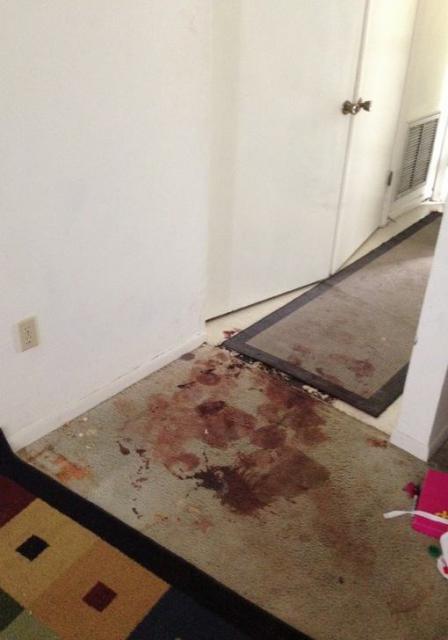 Close-up view of the exit from the living area to the foyer leading to the front door, showing the blood in the area where the fallen body was found.
Close-up view of the exit from the living area to the foyer leading to the front door, showing the blood in the area where the fallen body was found.
Then at that 11:30, the agent, giving no explanation (and exercising an authority he did not have, since Taramov was not under arrest and was not even being officially interrogated, and was thus legally free to move around as he pleased), told Taramov he would “have to leave.” He refused Taramov’s request to remain in the parking lot, and ordered him instead to go to a local restaurant far from the residential neighborhood where Todashev lived, and where he said he knew Taramov and Todashev liked to hang out. Agent Chris promised to bring Todashev there to him when the questioning was over.
Removing a Witness?
However to make sure Tamarov actually left the area and went to the restaurant, Agent “Chris” reportedly rode along in Taramov’s car, calling for another vehicle to pick him up and return him to Todashev’s apartment.
Growing fearful of what might be happening, Tamarov, after getting no response to texts he sent to Todashev’s phone, shortly later drove back to the apartment himself only to find lots of police cars in the parking area, helicopters in the air and crime scene tape surrounding the house.
Todashev had been killed during his friend’s enforced absence. Meanwhile, his supposed “confession” could not be attested to by another agent on the Agency’s Form 302, because agent “Chris” wasn’t there to witness it.
Coroner Wecht says, “To my knowledge not having a second agent present was not according to procedure. Also if they had awareness that this guy could be violent and dangerous — and they should have — that would not be a way to proceed. I find that absence of a second agent very puzzling. Even if a state trooper were there, usually the FBI doesn’t work like that. They like to run the show and to use their own people.”
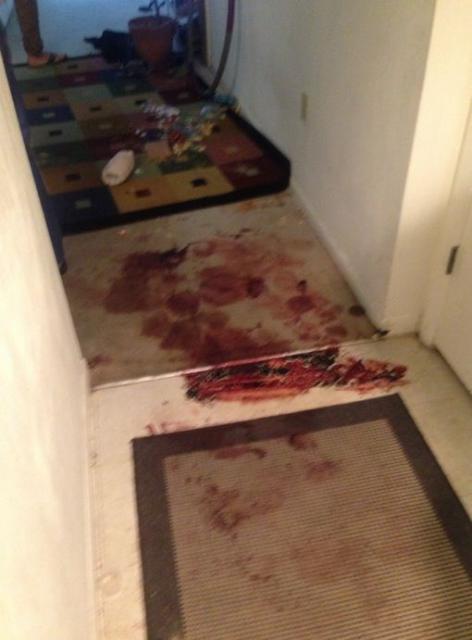 The pooled blood, viewed from the perspective of the front door, through the foyer, looking into the apartment.
The pooled blood, viewed from the perspective of the front door, through the foyer, looking into the apartment.
Besides, there was no real reason for “Chris” to be out in the parking lot keeping Taramov away. He could have had one or both of the Massachusetts troopers do that, or could have called on the Orlando Police, so he could do his crucial job of backing up the interrogating agent and verifying the Form 301 report.
The Shooting and the Do-Nothing State Trooper
In a recent lengthy public radio report on this case that ran on “This American Life,” Boston radio reporter David Boeri claims a “law enforcement source,” which he later slips and identifies as a Massachusetts State Police officer, was also in the room with the agent and Todashev at the time of the shooting. If correct that means there would have been an armed officer who allegedly witnessed an attack on the agent, and the agent’s shooting of that attacker, but who took no action himself to stop Todashev. Remember, all seven shots, according to the coroner, were fired by the FBI agent.
Wecht scoffs at that account saying, “The agent’s story doesn’t hold up. He says he was in danger for his life. If that was the case, how come the state trooper didn’t intervene? That doesn’t make sense to me. I know from police shootings over the years. They don’t say, ‘Okay, Joe, you do the shooting. I’ve got your back.’ They all shoot, and you end up having to figure out who shot which bullets.”
Interestingly, the bullets were taken from the Medical Examiner by the FBI, an action which Wecht says was also not correct, as they are evidence in an open homicide case that “should be investigated by local or state authorities, not the FBI.”
At the very least, if the FBI’s claim were true that Todashev had actually confessed to the Waltham triple murder just before he was killed, this whole incident represents a colossal failure by the two FBI agents on the case. Dead men don’t talk, the agency doesn’t tape interviews, and with one agent present, there’s no Form 302 to document anything.
Then too, because one agent was left alone to grill a man the FBI claims they knew to have a quick temper and to be a martial arts expert, and because on this particular interrogation, unlike earlier occasions, Todashev was not restrained or cuffed in any way during five hours of intense grilling and was free to strike out if, as alleged, he lost that reputed temper, any chance of getting that confession was blown from the beginning.
But the peculiar decision to leave one agent alone in the room, and the even more peculiar decision, just before the shooting, to have the other agent physically remove Todashev’s friend Tamarov from eye or even earshot, raise a more sinister possibility: was there a plan all along not to obtain a confession about a three-year old murder, but to eliminate a witness who knew Tamerlan Tsarnaev, and who may have known something about the planning of the year-ago Boston Marathon Bombing?
After all, the FBI is already taking heat from critics, including in Congress and in Boston, for failing to prevent the Marathon bombing, and in particular for failing to keep its eye on Tamerlan Tsarnaev. The US was warned about Tsarnaev by Russian intelligence a year before the bombing because he had reportedly met with Muslim militants in Dagestan on a visit to his family. The FBI had even visited him a year before the bombing and questioned him, but then says they dropped their investigation of him. What if Todashev knew otherwise, though? After all, we know that almost every terror event that the FBI has “foiled” since 9/11 has actually been largely or in part the work of an FBI informant or undercover agent. Was this one that went awry, and did Todashev know something about that? His girlfriend, Tatiana Gruzdeva, deported by ICE at the FBI’s urging though she had a valid visa and no criminal history, claims he appeared sad and upset on learning of the elder Tsarnaev’s death following the bombing, and of the claim by the FBI that he had been responsible for it.
And there is one more disturbing question. The shot into the top of the head, clearly a killing shot, according to both coroners Utz and Wecht if the usual FBI standard hollow-point projectile was used, could not have been fired at the time Todashev allegedly lunged at his interrogator. If it had been, he could never have made it to the egress leading into the foyer some 8-10 feet across the room. Nor could it have been fired over the intervening floorspace, as it would have felled him immediately, and would have led to blood appearing elsewhere.
Meanwhle, the lack of any blood on the walls at the exit area, as noted by the family’s private investigator, suggests Todashev was shot down on the floor, not standing.
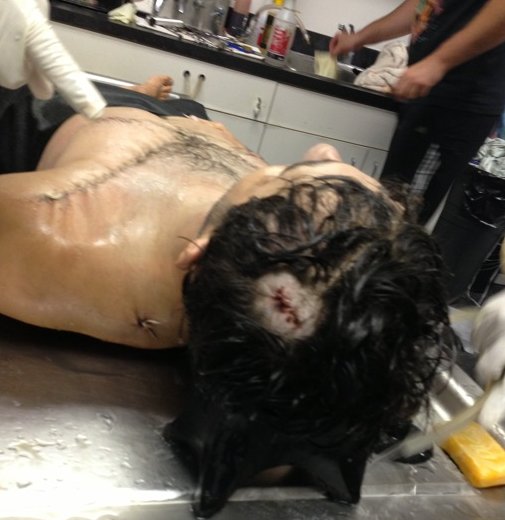 Todashev’s body, showing the spot where an FBI agent fired a kill shot into the top of his head.
Todashev’s body, showing the spot where an FBI agent fired a kill shot into the top of his head.
Was the Head Shot then a Coup de Grace?
Teyer has their own theory. Her career in the Army recently torpedoed by the FBI, which maliciously had her listed as a “security risk,” causing her to decide to retire from the service, the unintimidated Teyer says, “My theory is that Ibragim had too much information about Tamerlan, and they didn’t want that information to come out.”
What information would that be? Teyer, who is involved with a group fighting for the freedom of the surviving Tsarnaev brother, Dzhokhar, who faces death if convicted of the bombing, says she does not believe he and his brother Tamerlan were actually the Boston bombers, and says even if they were, they couldn’t have done it alone. “Look,” she says, “those two brothers couldn’t have come up with the idea of bombing the Marathon on their own! Someone would have had to plant the idea in their heads, and someone would have helped them plan it. Why do you think the police tried to kill Dzhokhar when he was hiding in the boat? They fired into that boat over 100 times. Why? He was already surrounded, and with Tamerlan dead, if he had been involved he would have been needed as a witness to find out if there were any accomplices or further attacks planned. Instead they tried to kill him.”
Saying it’s clear from all that has happened — the killings and the deportations and the blocking of people from returning to the US — that the FBI is simply eliminating witnesses to something. She adds, “I don’t know what Ibragim knew about Tamerlan, but he must have known something.”
It’s not such a wild speculation. Several news organizations have reported that all but one of the terrorist attacks between 2001 and the Boston bombing that were “disrupted” or foiled by the FBI have featured Bureau informants or undercover agents who played key roles in setting the plots in motion. Could the Boston Marathon bombing be a case of such an FBI-involved plot going somehow awry?
A call to FBI spokesman Paul Bresson to seek an explanation for the Bureau’s extraordinary ongoing 10-month hold on the coroner’s report on this killing and on its own lengthy investigation into the agent’s shooting of Todashev, as well as for an explanation for the decision to have only one agent with Todashev during an intense interrogation has so far gone unanswered.
A report is due out tomorrow by the Florida State’s Attorney in Orlando, Jeffrey L. Ashton, on this shooting. It is not clear what that conclusion will be. Ashton’s office send out terse note to the media over the weekend protesting an apparently FBI-leaked story claiming his investigation would also, like the Bureau, exonerage the agent in Todashev’s death. He said that his conclusion had not been reached yet, and called the leak “unfair to both the family and the agent.” A good question for Ashton, whatever his conclusion is, would be whether he had access to the witnesses who knew about the FBI’s harassment of Todashev between April 16 and his death on May 22, 2013, and especially to Todashev’s friend Taramov, the witness who was removed by the FBI from the vicinity of the shooting just before it happened. All those witnesses, were driven or deported out of the country by the FBI in the ensuing weeks after the killing, and Taramov, who left voluntarily to attend his friend’s funeral, was barred from returning to the US, despite his having a valid Green Card. Another question for Ashton would be whether his own investigators had access to the bullets removed from the Coroner’s office, and the many items removed from the apartment by the FBI.
Meanwhile, both the ACLU’s national office and its Massachusetts office, citing the “unbroken FBI track record of clearing its agents who use deadly force,” (that’s 150 agents cleared out of 150 agent shootings of witnesses or suspects over 18 years, not counting this latest shooting, according to a report in the New York Times), has objected to having the FBI investigating its own agent in this shooting and has called for an independent inquiry into Todashev’s death.
As Howard Simon, executive director of the national ACLU, said, in response to the Boston Globe’s report that the FBI study will exonerate its agent:
“As we said when we first called for an investigation into Todashev’s death, secrecy fosters suspicion. The DOJ should have called for a truly independent investigation of the shooting, and they still can! There remain too many unanswered questions about what happened in that Orlando apartment last May. Until they are answered—until the public knows exactly how and why FBI agents and police officers walked into an apartment to ask questions and walked out with a 27 year-old in a body bag—we will not stop our calls for transparency and answers.”
